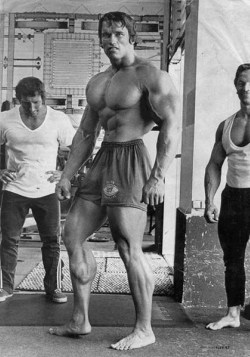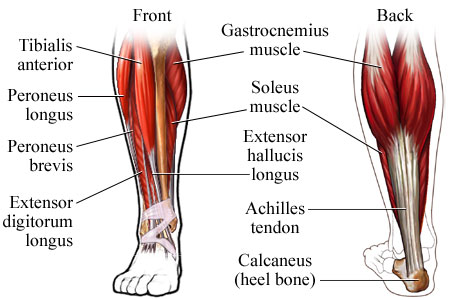When you think of calves, you picture the part of your leg that everyone else can see when you’re wearing shorts. Sure, you can have a huge upper body and quads, but if you have the calves of a 10-year-old boy, then people may often chuckle. To get past walking around with cringe-worthy chicken legs, you better employ a few of these best calf exercises as soon as possible to kickstart your calf growth.
Women prefer to have slim, shapely calves, and these exercises can help the females to accomplish their goals too. Ladies, don’t be afraid of training your calves just like men do… strong calves will even help you to walk better in high heels.
Of course, calf development is highly dependent upon your genetics. You can have very strong lifts, but the insertion points of the calf muscles are all that matters. Judges in bodybuilding competitions often do not put a lot of weight on the calves as a judging factor, but they do matter and are always good to have. And let me tell you, for those guys who think calves aren’t important on the beach, the women DO look, and, yes, they DO judge you for it!
Never fear though, if you do not have aesthetically pleasing, low insertion points, you can still bring your calves up quite a bit.
How to Get Big Calves
As mentioned above, you can be as strong as possible on all of the main calf lifts, but it won’t mean jack if you do not have the low insertions. Sure, they may have size, but they may just not be as noticeable. Face it, some people will have great calves and some will not. You should definitely still train them despite your genetics. Arnold had pathetic calves, but as you can see, he brought them up through hard work and dedication. You can do it too.
Anatomy of the Calves
The rear calf muscle has two main parts: The Gastrocnemius and the Soleus. The Gastrocnemius is made up of two heads: the medial and the lateral. These two heads will appear to form a diamond shape whenever they are fully developed. We love our standing calf raises to build the Gastrocs.
The Soleus is not visible looking at the body on the outside. It actually lies underneath the Gastrocnemius on the rear of the lower leg. The Soleus will be most active when doing exercises whenever your knees are bent. Having a strong Soleus is important to the thickness of your lower leg, helps to stabilize your ankles, and helps to protect your Achilles tendon. This is why doing seated calf exercises are also important.
The front of the calf consists mainly of the Tibialis anterior and a handful of other smaller muscles. The Tibialis anterior is responsible for helping to flex the ankle – to point your toes towards your head or to decrease the angle between the top of your foot and your shin. It’s not really all that important to train your Tibialis anterior, but if you want to, you can do some dumbbell shin curls:
Functions of the Calves
The function of the Gastrocnemius is to elevate the heel, which is also known as the plantar flexion. The function of the Soleus is pretty much the same. The only real difference between the two is that the Soleus works with the knee bent, while the Gastrocs work more with straight legs. The Tibialis works during every leg exercise, significantly more so when it involved pointing your toes toward your face.
The Top 5 Best Calves Exercises
1. Smith Machine Calf Raises
The lift: This is an exercise that you will want to use on a smith machine. The reason for this is that it will be much safer since there will be stabilization there. You will not want to fall backward. Plus, it will allow you to use more weight. Before you unrack the bar to start the lift, you will want to make sure there is some type of platform there.
Once you have the platform set up, you will want to have the heel of your shoe hanging off the back of the platform, so you can fully stretch the calf muscle down and back up. This is one of the best calf exercises for the full range of motion. Watch this video for a further visual explanation.
2. Seated Calf Raises
The lift: Start by sitting down on the seat of the machine. Plant your legs where necessary and lock your knees below the padding. You want to make sure that your heels are far enough off the platform so that you can get a good stretch with your calf muscles. You will want to make sure to start off light or you may experience your calves straining a bit. When you go down, get a nice stretch before going back up. Feel the squeeze once you move your knees upward.
The Soleus is one of the few muscles where you are probably better off going with higher repetitions, as it was made to withstand extremely high repetitive volume (walking). These types of calf movements are usually better off using an 8-15 rep range. Here is a video demonstration of how to perform this exercise. Here is a visual explanation.
3. Donkey Calf Raises
The lift: When you get on the machine, you will want to position your feet on the machine about shoulder-width apart. You will be leaning forward with your elbows and forearms on the padding in front of you. Make sure to get a good arch in your back and have your butt against the back lever which will move up and down. Whenever you are set, you will want to use your calves to move the lever up. You will not want to use your back or glutes to do this. That is where a lot of people fail.
The old 70’s bodybuilders like Arnold Schwarzenegger, Frank Zane, Dave Draper, Lou Ferrigno, and Franco Columbu found that most effective donkey calf raises are done with a partner. There are countless images and videos of bodybuilders sitting on each other, doing the donkey calf raises. It’s one of the classic best calf exercises.
4. Standing DB Calf Raises
The lift: You will want to start off by grabbing a dumbbell of your choice. You will probably want to start off light to get accustomed to the movement. Once you find your dumbbell, you will only need one. Hold the dumbbell with one hand. You will then need to find a platform to position your feet on. You will want the back of your heels to hang off slightly to get a good stretch. You will hold the dumbbell with one hand and use the other hand to hold onto something to make sure you keep balance.
As you can see, he is doing one leg at a time – which is just fine. You will be fine doing both legs at the same time if you wish though.
5. Single Leg Calf Press (Toe Push)
The lift: You will start out seated on a sled or some other leg press machine. Keep a slight bend in your knee when touching your toes on the platform. Unrack the weight by pushing your legs out to a full extension to set up for the exercise. You can choose to use both legs or a single leg. I make better progress using a single leg for most calf exercises.
Start the movement by extending your ankles and pointing your toes away from you, as far as possible. Then you will flex your ankles by pointing your toes as far back toward your head as possible. You should feel a full stretch in your calves at that point. That is one rep. Heavier weights can be used for this exercise, making it one of the best calf exercises for building strength. I have used 3-5 rep sets at times to build awesome calf strength that can then be used at slightly higher rep ranges to build mass.
Integrating Calf Training Into Your Workout
To integrate these best calf exercises into your training routine, you should pick one exercise that focuses on the Gastrocs (knees straight) and one that focuses on the Soleus (knees bent). I enjoy pairing the seated calf raise with the single-leg calf press. Normally I get great results from super-setting my calf training with completely unrelated muscles.
For example, I might hit my calf raises immediately after a set of bench presses, and then I might pair the calf press with triceps dips. Or if you want to focus 100% of your intensity on calf training, then you can train them separately. I would not superset two calf exercises together though, as fatigue from the first set will impair performance on the second set.
Calves can be trained every other day, just like most other muscles in the body. The Soleus can sometimes be trained after only 24 hours of rest, but I really wouldn’t recommend it. Turning your calves into cows is hard work, but it can be done in a few months when the best calf exercises are integrated properly into your training.
Tags: calf, calf training, calves, exercise technique, Weight Training, weightlifting













the donkey calf raises how can be if you don’t have the machine?
woah I'm ging to use these!
I never had big calves but lately I have been working them real good and I see a change in the way they look.
In reality, the Standing Dumbell Calf Raises are all that you need to turn those calves into cows.
working my calves.
Thank you for the education. This is what I have been looking for. Now I have the knowledge I need to build massive calves. I never really had a problem with speed just mass.
Great post once again Steve! I have one question though, did you think about making The Top 5 Best Forearm exercises some time in the near future? Would be really cool and practical because my grip (and many others) is the only thing that keeps me off from making better progress on heavy dead lifts. Thanks!!! Cheers 🙂
Thank you Steve! I have been waiting to see this from this site. One thing to mention. The video for your example of a Smith Machine Calf Raise is disabled by request. I personally think that having muscular calves will either make or break your leg impact. They are one of the first things I look at people when at the gym ( when discussing form or judging if they are a d-bag or not, hogging all of those machines and all ).
One question about that sitting calf raise demonstration you have up. I thought that for the seated calf raise to be in proper form you have to do a full ( top and bottom ) extension to get the most of the rep. Am I wrong in thinking this? The reason that I ask is because the guy in the video seems to do a half top extension.
Thanks again for adding this.
Thanks for your feedback Bryan. I replaced the smith machine calf raise video. The seated calf raises look fine to me; I think that guy is using a full ROM.
Any thoughts on also working out the shin muscle?
I updated the post with some information about the Tibialis anterior, aka the ‘shin muscle’. I should have originally included it, but you don’t really need to work it directly so I kind of blew it off. There are some cases where working the Tibialis can benefit you, especially when trying to improve your vertical jump.
Thanks for adding that! I suffer from shin splints and do a handful of excercises to strengthen the entire lower leg. I have not tried the dumbbell shin curls but will add that in.
What’s wrong with MuscleTech?
Two words: overpriced, overhyped.
I think that many people naturally forget to include calf exercises into their strength routines. The exercises you include are great. I like to include them on days I work back, glutes, and hams – also areas that people don’t focus their training on enough!